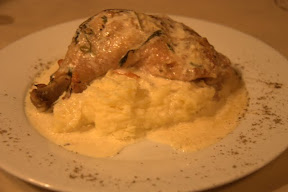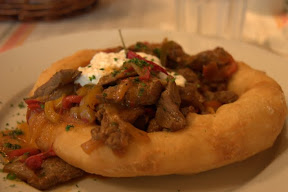Hungary in Budapest
I expected paprika to be featured in every dish while we were in Hungary. It certainly was popular, but Hungarian cuisine, at least in Budapest, extends past paprika. Although I did read that while you can find almost every type of cuisine in Budapest, good Hungarian restaurants are few and far between. Budapest seemed to have lots of restaurants that have a Hungarian flair without only serving traditional dishes. One of our favorites was M Restaurant, a little bistro with a small but varied menu. The walls are covered with brown paper with drawings of the inside of a house. We both had a tasty spiced chicken. Very creamy and rich, but delicious.
Then there was Menza, located on a busy street lined with restaurants. Once you go inside, Menza stands out due to its stylish retro décor and its way of making ordinary dishes seem fancier.
We tried the ubiquitous goulash there (served in the form of a soup) and a spicy beef stew like dish – both very tasty and flavorful.
We ate at the Hummus Bar, which serves giant Israeli pitas (which, obviously, was not Hungarian). We also liked Klassz, a slightly more upscale but unpretentious restaurant with an extensive wine list on Andrassy Boulevard.
And, I would be remiss not to mention my favorite ice cream place. The people in Budapest must love ice cream, because you could find it on almost every street. I was partial to the place down the street from us. I’m not sure of its name, so a lot of good it does anyone who visits Budapest, but it deserves a mention considering I ate ice cream there 5 out of the 6 nights we were in Budapest. It was slightly embarrassing to go in there night after night, but when the ice cream is good, you do what you have to do.
As you probably guessed by now, all of these except the Hummus Bar and the ice cream place were spotted by Budapest locals. (Sidenote: serious foodies might also want to check out chew.hu for in-depth coverage of the Budapest food scene).
One treat we were not fond of are the Hungarian langos. I had heard rave reviews about langos, which are savory fried doughnut like things. The basic langos appears to be topped with garlic. We tried one with garlic and cheese on top.
The first couple of bites were tasty, but the grease quickly overpowers anything else and you wish you hadn’t eaten as much as you did.
Bath time
The quintessential experience in Budapest is to visit a bath. Thermal springs bubble underneath the city, and someone decided long ago it would be a good idea to tap into them. We visited one of Budapest’s more famous baths, the Szechenyi Baths. Szechenyi is located in Budapest’s City Park at the end of stately Andrassy Boulevard. We didn’t know what to expect, but the baths turned out to be like a giant warm swimming pool. Except people don’t really swim, they just sort of hang out in the water.
There are three baths inside: one warm, one hot, and one positively freezing.
Outside, there is one hot bath (like a giant hot tub), a lukewarm one designed for more movement, and a warm one.
The baths were filled with people, including many locals. Hungarians believe the thermal waters have healing powers. Sean mostly complained he was hot (considering it was a 90+ degree day), but did admit that his knee, which can be sore at times, did feel better.
In the warm pool, there were giant jets bubbling up. I waited around to float in the bubbles, and noticed the jets were occupied almost exclusively by women. And once they found one, they weren’t giving them up. I wondered what all of the fuss was about and then it dawned on me.
Of course. The bubbles were like the Rejuvenator.
Budapest Love
We loved Budapest almost immediately. The city felt very modern, stylish and graceful, yet one also felt a sense of history there.
It has something many other cities lack: trees. From the broad, magnificent Andrassy Boulevard, which has trees on either side and a tree-lined pedestrian strip in the middle, to the canopy of trees lining pedestrian only streets, Budapest looked green and leafy. The trees had strong, thick trunks, indicating their history, which complimented the stately architecture well.
I’m fond of cities that are so big that they swallow up the tourists. Because interesting things were all over the city, you could walk down the street and be amongst people just going about their day.
While formerly communist like the other places we have visited recently, the communism in Hungary was not as strict as other countries, giving rise to the term “goulash communism.” Apparently the Russians allowed Hungarians more freedom, such as the freedom to travel, making Hungary more Westernized than the rest of Central/Eastern Europe.
I did not realize until we went that Budapest is often compared to Paris. It is easy to see the comparison, although Budapest felt more relaxed than Paris. Between the casual grace of the city and our super sweet (but cheap!) apartment, we certainly felt relaxed there.












